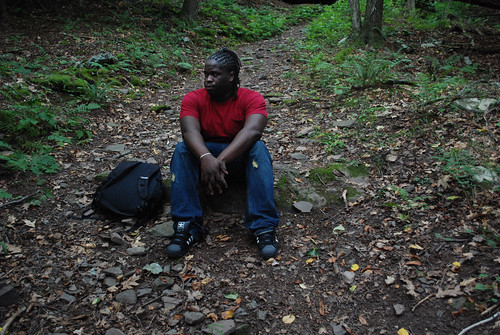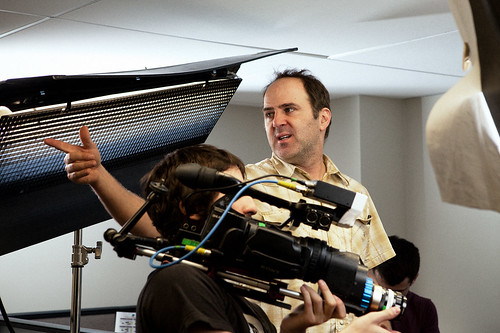Paul and I returned recently from a week in Park City, where we were able to see some of the many films screening at Sundance and Slamdance Film Festivals. At both festivals, we encountered self-reliant filmmakers making challenging and fascinating work. So, to give blog readers a taste of some of what we encountered, we'll be posting a series of short interviews with some of the makers to highlight and showcase some of the fresh, new work out in the world. Up first is an interview with filmmaker Keith Miller, whose feature, Welcome to Pine Hill, premiered at Slamdance and took home the grand jury award for narrative feature. We corresponded via email shortly after his premiere and before his award.
***

Welcome to Pine Hill is, as writer-director Keith Miller, put it, an example of "committed and concerned filmmaking that is engaged with social realities." Based on a real-life argument and encounter with Shannon Miller, a non-actor who portrays a character similar to himself in the film, Welcome to Pine Hill explores the disconnect between social classes in Queens and the challenges that come with trying to turn one's life around with a filmmaking approach that blurs the line between fiction and non-fiction. Told in long takes with exceptional handheld photography, it is a moving portrait about privilege, social ties, and mortality.
Welcome to Pine Hill is also a 2011 Independent Filmmaker Lab participant and Miller's debut feature. The short film, Prince/William, that the feature expands upon can be seen on feature's Kickstarter campaign page here. SRF readers might also be interested in this video interview with director Keith Miller by Filmmaker Magazine.
***
Your film, Welcome to Pine Hill, was inspired by an actual argument that you had upon meeting Shannon Harper. Because Shannon portrays a character in the film much like himself (i.e. his character's jobs are ones Shannon actually had in the past; Shannon is from the area where his character resides, etc.), I'd like to hear more about your process of collaboration with Shannon and the other actors/non-actors in the film. What kinds of input did Shannon and others contribute to scenes and/or the film's storyline? Were they involved at all in the editing process of the film? Along these same lines, you are credited as the film's screenwriter. Approximately, how much of the film was improvised/non-scripted?
Working on the short, Prince/William, Shannon and I had a number of long discussions about the implications of our initial meeting and, from these developed the basic plot for Prince/William. When we were shooting, we worked through the conversation in a number of different ways, repeating sections, until it felt like we had created the scene that we were going for.
The process of Pine Hill was a bit different. I had been planning on working with Shannon again, and he was interested, so I began writing the framework of the story based on elements from our conversations and other ideas I had for the storyline. I worked with the actors in very direct ways, both before and during the actual shooting. Before shooting I worked with them to get a sense of who they were and then talked to them about who their characters were and where we were going to go with the them.
Altogether the final script is about 30 pages. Some sequences are a single line in the script but are over ten minutes in the movie, like when he goes to the woods or after the doctor’s office when he is alone at home. Once we began shooting a scene that was not scripted I was constantly pushing the conversation in one direction or another and working with the actors in real time.
To put it bluntly, you're a white, middle class NYU arts professor telling a story about a nearly all-black cast in an impoverished area of Queens. How did you "unpack" the proverbial knapsack as you made this film? What role, if any, did the cast play in helping you navigate the racial/ethic/socio-economic spaces of the film's setting and story?
Addressing issues of race head on was one of the initial impulses for the short. This is so central to my thinking about the movie that I wrote a piece for the Huffington Post called, Who am I to tell this story?. One of the central issues for me is that discussions of race are often so gingerly touched upon that it really never gets addressed in a serious way by a lot of people. That said, I see Pine Hill more as a story about a personal journey that is set in black culture. One of the reasons I felt drawn to it was not as a window into the black world, but as an exploration of one man’s experience. In some ways, my being an outsider –being white in a black world- was one of the things that informed the storytelling process throughout. Shannon and I are very close and when we were working through scenes or discussing specific ideas, the issue of race was always present, but much more central were our many overlapping concerns, such as how he would react in a situation, what the meaning of that reaction was, what the choices were in a certain situation. When I was working with the other actors I pushed to get an intimate sense of who they were and how to most gracefully get them to put that forward with cameras rolling. Whether it was age or race, class or interests, I feel like our differences, the cast and mine, was what made me more able to work with them. The otherness that happens in front of the camera, the very artificiality of it, was what I was trying to undo; seeing that difference, between the actors and me, reality and filmed events, pushed a lot of those scenes into the space between both.
This film began as a short, which you premiered at the Rooftop Film Festival in the summer of 2010. How did you embark first upon making this film? What kinds of resources did you gather then and what additional ones were needed for the making of the feature-version?
This film was made almost completely with the energy, dedication and talent of the Brooklyn Filmmakers Collective. We are a very tight knit group of diverse filmmakers who workshop our passion projects. So when it came time to shoot, I proposed it to them and little by little they jumped on board. Another big help, in terms of the gear, was Ed David and his Kitty Guerilla Films. Without his generosity we would have shot on iPhones or something like that.
As the project moved forward, people began to take a liking to it and offered to help in a lot of different ways. A number of my former students (from NYU’s Gallatin School) came on board; more of the BFC members offered their help. The music is from the crews’ friends’ bands and the post people came from word of mouth. Being selected for the IFP Narrative Lab was yet another another boost as both the filmmakers and the IFP crew have been extremely supportive. In the end, the making of this movie was an amazing community effort.
The film captures a number of intimate and poignant scenes (for instance, an older man "lectures" the group of men drinking beer in the backyard with Shannon, telling them how to make their life count). How, literally and figuratively, did you capture these performances? What motivation or prompts did you use with to get these scenes going?
Most of the actors had not acted before and my focus was on getting a sense of who they were and then working with them to bring that out within the context of the scene we were shooting. It was a very hands on directing style but since the takes were so long and the camaraderie genuine, the tension you could feel or the potential stiffness of some situations, quickly faded away.
In most of the ensemble scenes we were shooting with three cameras rolling simultaneously, often doing takes of up to 45 minutes. We worked together to get a sense of the camera movements, the general tone, and how we would move as a group- all three cameras, the AC, the Boom op and me. The DPs are all experienced hand-held documentary film shooters with great skills and eyes, and the ability to keep a feel for the heart of the moment.
Finally, how can interested viewers hope to see Welcome to Pine Hill in the near future? How else might they connect with you and your work?
For the moment, the best way to connect with us is through the Facebook page. We plan to be playing some more festivals soon, but are still waiting on where to go next.

